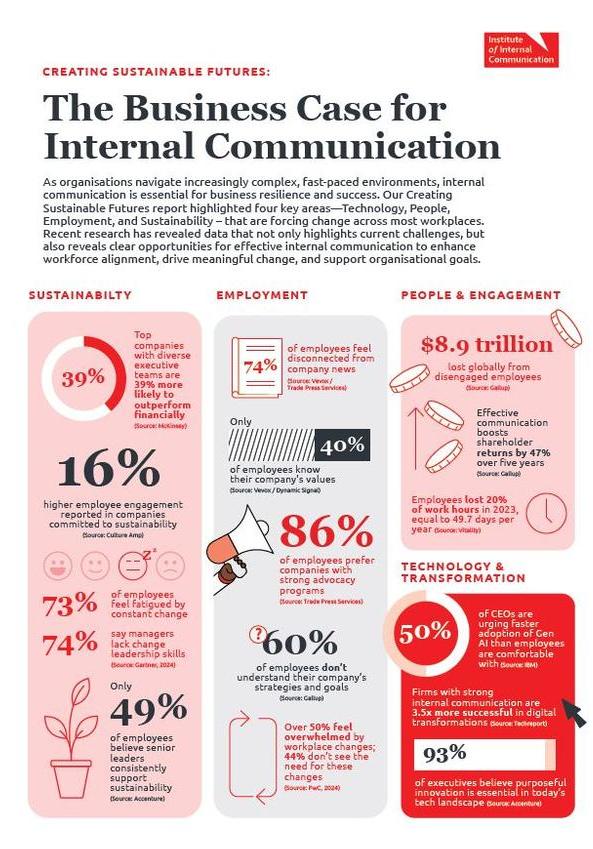Earlier in 2024, we launched our report, Creating Sustainable Futures for Internal Communication. This examines key trends shaping the future of work across four pivotal areas: people, workforce, technology and sustainability.
The report illuminates the opportunities these trends present for internal communicators. It emphasises the profession’s crucial role in driving engagement, alignment, and overall organisational success.
As the business case for internal communication grows, we have analysed and evaluated key data points across these four key areas. Our aim is to highlight how internal communication provides essential support as organisations navigate increasingly complex challenges to achieve successful outcomes.

- Technology: Facilitating digital transformation and AI adoption
In an era of rapid technological evolution, effective internal communication is fundamental to successful digital transformation.
Leadership teams increasingly recognise that cultural shifts are essential for scaling innovations like AI, but they face challenges related to organisational culture, collaboration, employee mindset and technology adoption.
Organisations with effective change communication programmes are more likely to outperform their peers, underscoring the critical role of internal communication in supporting and sustaining technological shifts.
Key insights:
- Generative AI adoption: According to recent research, over half of CEOs view generative AI as essential for success, with many advocating for faster adoption than employees may be comfortable with. A 2024 IBM survey revealed that 64% of CEOs believe their organisations must leverage rapidly advancing technologies that are outpacing employees' ability to upskill and adapt.
- Performance & change communication: Organisations with advanced internal communication practices are 3.5 times more successful during digital transformation programmes. Change initiatives that prioritise communication are up to seven times more likely to succeed, demonstrating the value of strong internal communication.
- Technical empathy: The growing importance of “technical empathy” enables technologists to explain complex concepts to less technical colleagues through relatable analogies, fostering understanding and reducing resistance.
- Culture and morale: When AI adoption successfully streamlines mundane tasks, research shows a positive impact on corporate culture, leading to a 72% increase in colleague engagement and improving morale for 79% of employees.
Furthermore, organisations that prioritise clear communication of innovation activities experience higher technology adoption rates. According to a recent survey by Accenture, 93% of executives agree that with rapid technological advancements, it is more important than ever for organisations to innovate with purpose. Internal communication can facilitate this by maintaining dedicated innovation platforms and scheduling regular showcases to keep employees engaged and informed.
Despite increasing investment in AI ethics frameworks, many employees report a lack of understanding of their organisation’s AI ethics policies. This highlights a key opportunity for internal communication. As Deloitte has written, organisations must “prioritise ethical and responsive use of AI for the betterment of work, workforce, and workplace through open communication, transparency, and documented governance processes.”
The business case for internal communication
Clear communication regarding the “why” behind technological change is crucial for increasing implementation success rates. By addressing awareness gaps, fostering transparency, addressing ethical concerns and providing relatable explanations, effective internal communication empowers colleagues, minimises resistance, and builds alignment with organisational goals. Ultimately, this accelerates successful technology adoption and long-term business outcomes.
- Sustainability: Driving engagement and trust
The role of internal communication in promoting sustainability initiatives cannot be overstated. Organisations that prioritise sustainability regularly experience higher engagement and performance among internal stakeholders.
Key insights:
- Equity, diversity and inclusion (EDI): McKinsey research shows organisations with high EDI scores are 39% more likely to financially outperform lower-scoring peers.
- Sustainability commitment: Colleagues at organisations perceived as genuinely committed to sustainability goals report a 16% increase in engagement levels, according to data gathered by Culture Amp. However, there are notable disconnects between C-suite perspectives and employee perceptions. As reported in ESG Today, 53% of Gen Z and 48% of Millennial respondents claim that sustainability has been deprioritised by their companies in recent years. This differs from the CxO perspective. 2023 Deloitte research showed 75% of surveyed C-Suite executives believed their organisation to have increased investment into sustainability initiatives.
- Sustainability say-do gaps: Accenture research has found less than half of employees (49%) believe senior leaders “walk the talk” on sustainability “often” or “always.” This leaves significant scope for improvement as any cynicism or mistrust will slow the pace of much-needed change. Internal communication has a key role to play in helping leaders authentically role-model sustainable behaviour.
The business case for internal communication
It’s clear the path to wholesale carbon emission reduction and sustainable business relies on authentic, robust, consistent, clear and transparent communication. Effective internal sustainability communication fosters engagement and retention, particularly among underrepresented groups. By addressing perception gaps, internal communication has a central role in ensuring all colleagues understand and are invested in sustainability efforts.
Prioritising the credibility of organisational sustainability commitments is essential. Strong internal communication builds trust and supports efforts for change.
- People: Enhancing engagement and productivity
The link between effective internal communication and colleague engagement is well-established. As far back as 2009, the MacLeod report identified four enablers of engagement. Employee voice, strategic narrative, engaging managers and organisational integrity all rely on effective internal communication. Organisations that communicate effectively are more likely to have engaged, productive, and high-performing employees.
Key insights:
- Lost productivity: Gallup research shows worldwide disengagement costs a staggering $8.9 trillion in lost productivity. This represents 9% of global GDP. In contrast, according to data analysis collated by Vevox, organisations with effective communication practices see a 47% increase in shareholder returns over five years.
- Increased profitability: Other research by Gallup shows engagement has a significant impact on both staff attendance and bottom-line outcomes. The data showed an 81% difference in absenteeism rates between top- and bottom-quartile business units and teams, and a 23% difference in profitability between the same. Internal communication-fuelled colleague engagement has a huge positive impact on organisational performance.
- Leadership communication: Tragically, however, recent McKinsey research found only 25% of respondents felt their organisations’ leaders to be engaging, passionate and inspiring. Business leaders must improve the way they role-model productive and engaging behaviour – and internal communication is expertly positioned to coach and support.
- Wellbeing communication: Organisations with robust wellbeing communication programmes experience reduced staff turnover and health-related productivity losses, according to research produced by UK-based health insurance provider Vitality. Data gathered in 2023 for Britain’s Healthiest Workplace – the UK’s largest employee wellbeing survey – showed employees lost 20% of working hours. This equates to 49.7 productive days lost per employee per year.
Of note, those under the age of 35 lose 48% more productive time due to absence and presenteeism than older colleagues. Across the board, colleagues need help to understand – and use – the health services available via workplace wellbeing programmes.
The business case for internal communication
Effective internal communication is an organisational superpower. Those leaders that invest in it are far better equipped to engage, inspire, and maximise the potential of their teams, while enhancing wellbeing. As organisations navigate increasingly complex operating conditions, internal communication helps to sustain engagement and productivity, ultimately boosting performance and growth.
- Employment: Building trust and alignment
As the 2024 IC Index illustrated, belief in organisational strategy is a key driver of trust. However, many colleagues feel uninformed about their organisation’s strategies and values. When they don’t understand it in a way that is meaningful at a personal level, they are unable to contribute towards its execution.
Key insights:
- Awareness gaps: A meta-analysis conducted by Vevox highlighted Gallup’s finding that 60% of employees do not know their organisation’s strategies, goals or tactics. The same analysis cited Dynamic Signal research that only 40% of employees were aware of their company's values and 74% felt they missed company news and information. These information gaps clearly need filling.
- Trust in leadership: Edelman’s 2023 Trust Barometer found business leaders to be more trusted than politicians or the media, with the latter widely perceived as sources of misinformation. But even trust in business leaders hangs in the balance. As the latest IC Index shows, only 51% trust their leaders. Pertinently for internal communicators, the IC Index shows a 74-point difference in the level of trust in senior leaders between those who rate communication as excellent and those who rate it as poor. Leadership communication, trust and engagement are intricately linked.
- Navigating continuous change: A maelstrom of forces is disrupting economic stability. The pandemic, supply chain shortages, war in Ukraine and the Middle East, political polarity and extreme weather events – all of these have destabilised business, creating uncertainty and demanding ongoing market responsiveness. PwC’s 2024 Global Workforce Hopes and Fears Survey found more than half of workers feel there’s too much change at work happening at once, while 44% don’t understand why things need to change at all. Colleagues want and need to feel a sense of consistency at work.
The business case for internal communication
When internal communication is prioritised, it addresses awareness gaps and builds trust and alignment within organisations. It lowers staff churn and improves performance.
By prioritising trust and leadership communication, organisations enhance colleague understanding of organisational strategy, vision and values. In this way, they are far more likely to withstand the pressures of external market forces, evolving and sustaining themselves into the future.
Conclusion
The insights from Creating Sustainable Futures for Internal Communication reinforce the critical role of internal communication across technology, sustainability, people and employment. As we showcase the business case for internal communication, we aim to empower internal communicators to advocate for their strategic role in guiding organisations through the disruption and transformation that characterises mid-2020s workplaces.
We will continue to explore and evaluate the research that underscores the value of internal communication. By understanding and leveraging trend analysis, internal communicators can effectively demonstrate their impact on organisational performance, driving meaningful and lasting behavioural change within their organisations.
Download the infographic below:






